Do you like spending time outdoors but hate getting lost? Do you enjoy hiking, biking, or kayaking but don’t want to constantly check your map and compass? If so, then you need a handheld GPS device! These nifty gadgets can guide you anywhere you want to go without having to worry about memorizing directions or stumbling around in the dark. Keep reading for our roundup of the best Garmin GPS for hiking on the market today! (Buying Guide)
Garmin is the Best Brand for Handheld GPS, And Why Should You Trust them?
There are a number of great brands that make handheld GPS devices, but in my opinion, the most trusted brand for these gadgets is Garmin. With over 20 years of experience in the industry, Garmin has developed a range of high-quality handheld GPS products that offer exceptional accuracy and ease of use. Their products come loaded with advanced features like GPS navigation, real-time traffic updates, 3D terrain mapping, and more, all at an affordable price point. If you’re looking for a reliable and user-friendly handheld GPS device, then I definitely recommend checking out Garmin’s lineup!
My 6 Recommendation for the Best Garmin GPS for Hiking:
1) Garmin GPSMAP 66i, GPS Handheld, and Satellite Communicator
The Garmin GPSMAP 66i is the perfect handheld GPS and satellite communicator for any adventure. With its large 3-inch sunlight-readable color display, you can easily see your location, even in direct sunlight. The GPSMAP 66i also features the triggering of an interactive SOS, so you can send a distress signal and receive help in an emergency situation.
Additionally, the two-way messaging via the 100% Global Iridium satellite network lets you stay in touch with family and friends while you’re on your adventure. And with the preloaded Garmin TOPO mapping, you can see your surroundings in detail, even when you’re off the beaten path. Furthermore, the multiple global navigation satellite system and cellular connectivity keep you connected even with no cell service.
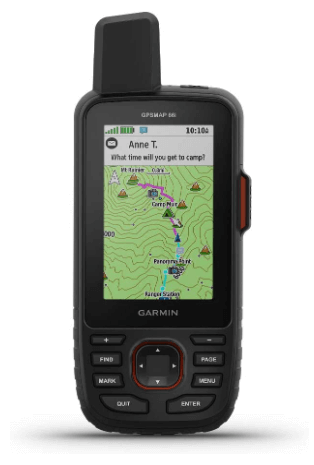
Features Of Garmin GPSMAP 66i:
- 3-inch large sunlight-readable color display
- Trigger an interactive SOS
- Two-way messaging via the 100% Global Iridium satellite network
- Preloaded Garmin TOPO mapping
- Multiple global navigation satellite system
- Cellular connectivity
- Compatible with the Garmin Explore website and app
- Helps you manage routes, waypoints, collections, and activities
- Internal rechargeable lithium battery
- Up to 35 hours of battery life
Pros:
- 100-hour battery for messaging,
- SOS, and satellite-based weather forecasts.
- Durable, waterproof, and rugged case
Cons:
- More expensive than other models
2) Garmin Montana 700, Rugged GPS Handheld
Looking for a handheld GPS that can stand up to the rigors of your outdoor adventures? Look no further than the Garmin Montana 700. This best handheld GPS is designed to withstand thermal, shock, water, and vibration exposure and provide stable satellite reception thanks to its multi-GNSS support. The 5″ glove-friendly touchscreen display is 50% larger than the previous model, making it easy to view even in bright sunlight. Plus, with the preloaded TopoActive maps, you’ll always know where you are and how to get back to civilization. And if you ever do find yourself lost in the wilderness, the Montana 700’s outdoor navigation sensors will help you find your way home.
With ANT+ technology, Wi-Fi connectivity, and BLUETOOTH wireless networking, you can access BirdsEye Satellite Imagery downloads, location sharing, Connect IQ app support, etc. Moreover, with the Garmin Explore website and app, you can manage waypoints, routes, collections, and activities, use tracks, and review trip data from the field. Whether you’re hiking or camping in the backcountry or biking or running on your favorite trail, the Montana 700 has everything you need to stay connected and safe.
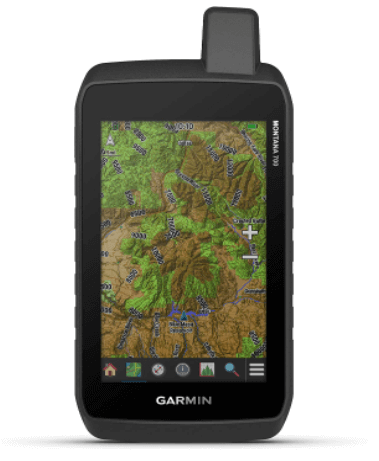
Features Of Garmin Montana 700:
- 5″ glove-friendly touchscreen display
- Preloaded TopoActive maps
- Outdoor navigation sensors
- ANT+ technology, Wi-Fi connectivity, and BLUETOOTH wireless networking
- BirdsEye Satellite Imagery downloads
- Location sharing
- Connect IQ app support
- Manage waypoints, routes, collections, and activities
- Use tracks
- Review trip data from the field
- In-built compass & barometric altimeter sensor
- 3-axis electronic compass with automatic calibration
Pros:
- Big touchscreen
- Shock and water-resistant
- Fast processing speed
Cons:
- More expensive
3) Garmin Rino 755t, Rugged Handheld
If you’re looking for a tough and reliable handheld GPS device, the Garmin Rino 755t is perfect. This rugged little unit is packed with features that make it ideal for outdoor use, including high-sensitivity GPS and GLONASS satellite reception, extended range two-way radio, and unit-to-unit text messaging. Additionally, the position reporting feature lets you keep tabs on other Rino users in your group.
The 3″ sunlight-readable touchscreen display is easy to use, even in direct sunlight and can be switched between landscape and portrait orientation. And with a dual battery system, you can get up to 14 hours of use on a single charge. This best handheld GPS is a great companion whether you’re hiking, camping, or just exploring the great outdoors.
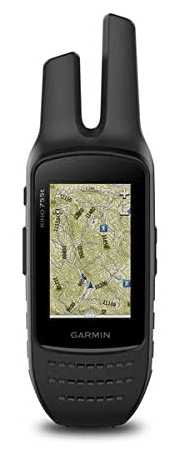
Features of Garmin Rino 755t:
- 3″ sunlight-readable touchscreen display
- High-sensitivity GPS and GLONASS satellite reception
- Extended range two-way radio
- Unit-to-unit text messaging
- Position reporting feature
- Dual battery system
- In-built electronic compass & barometric altimeter sensor
Pros:
- Sunlight readable large display
- Extended range two-way radio
- Long battery life
- Rugged and waterproof
Cons:
- The screen resolution is not the highest.
4) Garmin inReach Explorer+
The Garmin inReach Explorer+ is a handheld satellite communicator that offers 100 percent global Iridium satellite coverage. With this device, you can enjoy two-way text messaging from anywhere in the world (satellite subscription required). You can also trigger an interactive SOS to the 24/7 search and rescue monitoring center.
In addition, the inReach Explorer+ lets you track and share your location with family and friends. Plus, it comes with preloaded Delorme topo maps with onscreen GPS routing, so you can always find your way. The device is also water-resistant (IPX7) and has a rechargeable internal lithium-ion battery. You can pair it with mobile devices using the free Earthmate app for even more features.
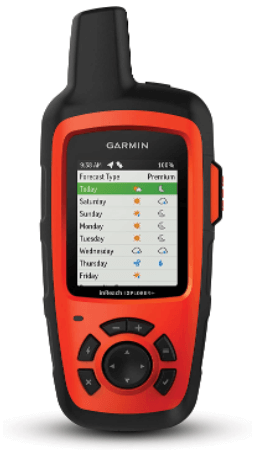
Features of Garmin inReach Explorer+:
- 100 percent global Iridium satellite coverage
- Two-way text messaging
- Interactive SOS
- Track and share your location
- Preloaded Delorme topo maps with onscreen GPS routing
- Water-resistant (IPX7)
- Rechargeable internal lithium-ion battery
- Pair with mobile devices using the free Earthmate app
Pros:
- Lightweight and compact
- Up to 100-hour long-life battery
- IPX7 water-resistant rating
- Unlimited sending of preset messages
Cons:
- On the inReach SE+, no mapping is available.
5) Garmin eTrex 32x, Rugged Handheld GPS Navigator
Looking for a reliable and rugged handheld GPS navigator? Look no further than the Garmin eTrex 32x. This tough little device is preloaded with Topo Active maps with routable roads and trails, making it perfect for cycling and hiking. And with the support of GPS and GLONASS satellite systems, you can track your progress in even the most challenging environments.
Moreover, with 8 GB of internal memory for map downloads and a micro SD card slot, you can keep your eTrex 32x loaded with all the latest maps and data. And when the batteries start to run low, simply pop in a couple of AA batteries, and you’re good to go for up to 25 hours in GPS mode. So, whether you’re tackling a tough hike or just exploring the great outdoors, the Garmin eTrex 32x is a great choice.
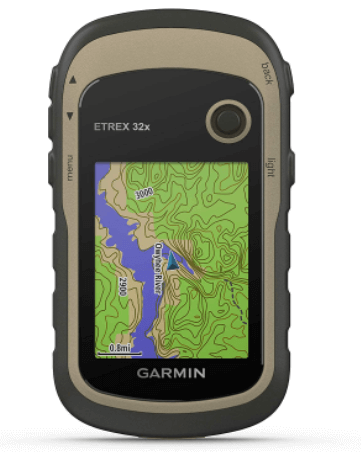
Features of Garmin eTrex 32x:
- Stay on track with the reliable handheld GPS
- View maps in color and improved readability
- Get guidance for cycling and hiking with routable roads and trails
- Use GPS and GLONASS satellite systems for tracking in more challenging environments
- Store data on the device or expand storage with a micro SD card slot
- With up to 25 hours of battery life, explore for days
Pros:
- Compact, lightweight, and handy
- Excellent GPS reception
- Wide range maps
- Long-life battery
Cons:
- Screen a little small
6) Garmin eTrex 22x, Rugged Handheld GPS Navigator
Looking for a reliable handheld GPS navigator that can take you anywhere? Look no further than the Garmin eTrex 22x. This tough little device is preloaded with Topo Active maps so that you can explore with confidence on roads and trails. Plus, it supports both GPS and GLONASS satellite systems, so you can track your location even in challenging environments.
With 8 GB of internal memory and a micro SD card slot, you can download all your maps. And with up to 25 hours of battery life in GPS mode, you can keep going all day long. So, whether you’re hiking, cycling, or just venturing into the great outdoors, the eTrex 22x is your perfect partner.
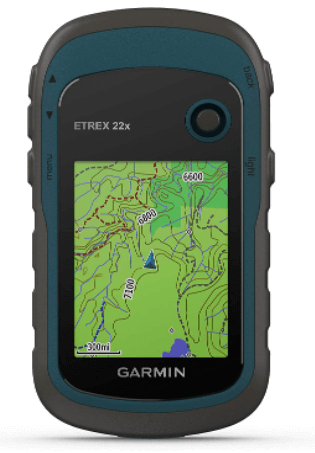
Features Of Garmin eTrex 22x:
- Preloaded with Topo Active maps
- Supports GPS and GLONASS satellite systems
- 8 GB of internal memory
- Micro SD card slot
- Up to 25 hours of battery life in GPS mode
Pros:
- Large and bright display
- Easy to use and navigate
- 8 GB memory
- Long-life battery
- Durable and waterproof
Cons:
- Does not come with an electric compass
How To Choose the Best Handheld GPS?
When choosing the best handheld GPS, there are several things you need to keep in mind:
1) Maps:
The handheld GPS should be preloaded with maps of the area you plan to explore. If you’re planning to hike or cycle in unfamiliar territory, it’s also good to get a device that supports topographic maps.
2) Battery Life:
Long battery life is essential for any handheld GPS. Look for a device that can operate for at least 10 hours on a single charge. And if you’re planning to use the GPS for extended periods, consider getting a model with an AA battery backup.
3) Display: Screen Size and Readability:
The handheld GPS should have a large, easy-to-read display. And if you’re going to be using the device in bright sunlight, look for a model with an LED-backlit screen.
4) Satellite Systems:
Most handheld GPS devices rely on the Global Positioning System (GPS) for tracking. However, in some areas, GPS coverage can be unreliable. If you’re planning to use the GPS in a remote area or with no cell phone reception, consider getting a model that supports both GPS and GLONASS satellite systems.
5) Touchscreen vs. Buttons:
Some handheld GPS devices feature a touchscreen interface, while others have buttons. There are pros and cons to both. Touchscreen models can be easier to use, but they can also be more difficult to see in bright sunlight. Button-operated models can be more difficult to use, but they’re usually easier to read in direct sunlight.
6) Durability:
If you’re planning to use the handheld GPS in rough conditions, look for a waterproof and shockproof model.
7) Weight and Size:
Handheld GPS devices come in a variety of sizes and weights. If you’re planning to carry the device in your pocket or backpack, consider getting a compact model. But if weight is not an issue, you might prefer a larger model with a bigger screen.
8) Altimeter, Barometer, and Compass (ABC):
If you’re an avid outdoors fan, you might want to get a handheld GPS that includes an altimeter, barometer, and compass. These features can help navigate unfamiliar terrain.
9) Price:
Handheld GPS devices range in price from around $100 to $500. If you’re on a budget, you can find a good quality device for under $200. But if you’re looking for the best of the best, you’ll need to spend closer to $500.
10) Extras:
Some handheld GPS devices come with additional features, such as tracking your fitness activity or receiving weather updates. If these features are important to you, look for a model that offers them.
FAQ’s
What is the best handheld GPS for hiking?
I personally think that the best handheld GPS for hiking is the Garmin eTrex 22x. It’s a rugged, waterproof device that supports topographic maps and has long battery life.
What is the most accurate Garmin handheld GPS?
I think that all Garmin handheld GPS are the most accurate. They are compact and lightweight devices supporting GPS and GLONASS satellite systems.
Is there a handheld GPS that doesn’t require cell service?
Yes, handheld GPS devices don’t require cell service. However, they do require a clear view of the sky, so they may not work well in heavily forested areas.
What is the best handheld GPS for geocaching?
I believe that the best handheld GPS for geocaching is the Garmin eTrex 22x. It’s a compact and lightweight device that supports topographic maps and has long battery life.
How accurate is a handheld GPS?
Most handheld GPS devices are accurate within a few meters. However, accuracy can be affected by factors such as satellite coverage and signal interference.
Conclusion:
The best handheld GPS will vary depending on your needs and budget. However, all the models on our list are great choices for anyone looking for a reliable and easy-to-use GPS device. So, whether you’re an experienced hiker or a first-time camper, you’re sure to find the perfect GPS for your next adventure. I hope you enjoyed reading this article and if you think I forgot something or if you simply want to share a story or any advice, feel free to leave a comment below. Be Safe and Happy trails!

